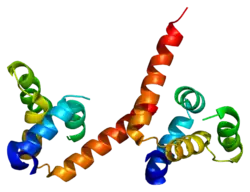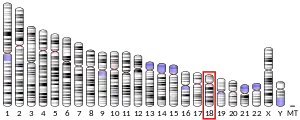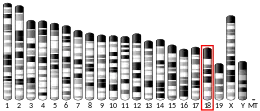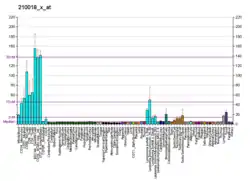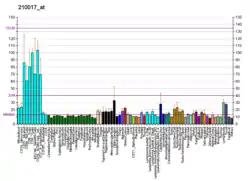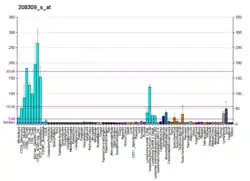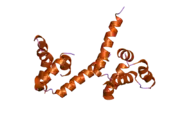Mucosa-associated lymphoid tissue lymphoma translocation protein 1 is a protein that in humans is encoded by the MALT1 gene.[5][6][7] It's the human paracaspase.
Function
Genetic ablation of the paracaspase gene in mice and biochemical studies have shown that paracaspase is a crucial protein for T and B lymphocytes activation. It has an important role in the activation of the transcription factor NF-κB, in the production of interleukin-2 (IL-2) and in T and B lymphocytes proliferation[8][9] Two alternatively spliced transcript variants encoding different isoforms have been described for this gene.[10]
In addition, a role for paracaspase has been shown in the innate immune response mediated by the zymosan receptor Dectin-1 in macrophages and dendritic cells, and in response to the stimulation of certain G protein-coupled receptors.[11]
Sequence analysis proposes that paracaspase has an N-terminal death domain, two central immunoglobulin-like domains involved in the binding to the B-cell lymphoma 10 (Bcl10) protein and a caspase-like domain. The death domain and immunoglobulin-like domains participate in binding to BCL10. Activation of MALT1 downstream NF-κB signaling and protease activity occurs when BCL10/MALT1 gets recruited to an activated CARD-CC family protein (CARD9, -10, -11 or -14) in a so-called CBM (CARD-CC/BCL10/MALT1) signaling complex.
Paracaspase has been shown to have proteolytic activity through its caspase-like domain in T lymphocytes. Cysteine 464 and histidine 414 are crucial for this activity. Like metacaspases, the paracaspase cleaves substrates after an arginine residue. To date, several paracaspase substrates have been described (see below). Bcl10 is cut after arginine 228. This removes the last five amino acids at the C-terminus and is crucial for T cell adhesion to fibronectin, but not for NF-κB activation and IL-2 production. However, using a peptide-based inhibitor (z-VRPR-fmk) of the paracaspase proteolytic activity, it has been shown that this activity is required for a sustain NF-κB activation and IL-2 production, suggesting that paracaspase may have others substrates involved in T cell-mediated NF-κB activation.[12] A20, a deubiquitinase, has been shown to be cut by paracaspase in Human and in mouse. Cells expressing an uncleavable A20 mutant is however still capable to activate NF-κB, but cells expressing the C-terminal or the N-terminal A20 cleavage products activates more NF-κB than cells expressing wild-type A20, indicating that cleavage of A20 leads to its inactivation. Since A20 has been described has an inhibitor of NF-κB, this suggests that paracaspase-mediated A20 cleavage in T lymphocytes is necessary for a proper NF-κB activation.[13]
By targeting paracaspase proteolytic activity, it might be possible to develop new drugs that might be useful for the treatment of certain lymphomas or autoimmune disorders.
Interactions
MALT1 has been shown to interact with BCL10,[14] TRAF6 and SQSTM1/p62.
Protease substrates
MALT1 (PCASP1) is part of the paracaspase family and shows proteolytic activity. Since many of the substrates are involved in regulation of inflammatory responses, the protease activity of MALT1 has emerged as an interesting therapeutic target. Currently known protease substrates are (in order of reported discovery):
| Substrate | Reference | Cleavage sequence | |
|---|---|---|---|
| A20 (TNFAIP3) | [13] | LGASR/G | |
| BCL10 | [12] | LRSR/T | |
| CYLD | [15] | FMSR/G | |
| RELB | [16] | LVSR/G | |
| regnase-1/MCPIP1 (ZC3H12A) | [17] | LVPR/G | |
| Roquin-1 (RC3H1) | [18] | LIPR/G | |
| Roquin-2 (RC3H2) | [18] | LISR/S | |
| MALT1 auto-proteolysis | [19] | LCCR/A | |
| MALT1 auto-proteolysis | [20] | HCSR/T | |
| HOIL1 (RBCK1) | [21][22][23] | LQPR/G | |
| N4BP1 | [24] | FVSR/G | |
| CARD10 | [25] | LRCR/G | |
| ZC3H12D | [26] | LVPR/G | |
| ZC3H12B | [26] | LVPR/G | |
| TAB3 | [26] | LQSR/G | |
| CASP10 | [26] | LVSR/G | |
| CILK1 | [26] | LISR/S | |
| ILDR2 | [26] | GASR/G LVSR/T GASR/G | |
| TANK | [26] | HIPR/V | |
| Tensin-3 | [27] | R614, R645 |
Specifically by the oncogenic IAP2-MALT1 fusion:
Protease inhibitors
Since MALT1 protease activity is a promising therapeutic target, several different screenings have been performed which have resulted in different types of protease inhibitors.[30] There is active competition between multiple pharma companies and independent research groups in drug development against the MALT1 protease activity.[31]
- Substrate peptide-based active-site inhibitor: Initially described with the metacaspase inhibitor VRPR-fmk.[12] Others have developed peptide inhibitors based on the optimal peptide sequence (LVSR) or further chemical modifications. Janssen Pharmaceutica is currently performing a clinical trial with this class of inhibitors.[32]
- Phenothiazine compounds like mepazine and chlorpromazine (which have been used clinically for neurological/psychological conditions) have been found to be allosteric inhibitors of MALT1 protease activity.[33][34]
- Biperiden, like phenothiazines, act as a MALT1 protease inhibitor and show promising results against pancreatic cancer.[35]
- A molecular modeling approach led to the development of the small molecule active site inhibitor MI-2.[36]
- Analogs of β-Lapachone have been identified as MALT1 protease inhibitors.[37]
- Quinoline and thiazolopyridine allosteric MALT1 protease inhibitors have been demonstrated to work in mouse disease models.[38]
- secondary metabolites (oxepinochromenones) from the fungus Dictyosporium show MALT1 protease inhibitory activity.[39]
- Novartis is developing pyrazolopyrimidine derivative MALT1 protease inhibitors.[40][41]
- VIB is developing MALT1 protease inhibitors in collaboration with the Leuven-based spin-off Centre for Drug Design and Discovery (CD3) [42][43]
- AstraZeneca is developing MALT1 protease inhibitors.[42] [44]
- Lupin and AbbVie are developing MALT1 protease inhibitors.[45]
- Chordia therapeutics is entering a clinical trial with a MALT1 protease inhibitor in 2020 [46]
See also
References
- 1 2 3 GRCh38: Ensembl release 89: ENSG00000172175 - Ensembl, May 2017
- 1 2 3 GRCm38: Ensembl release 89: ENSMUSG00000032688 - Ensembl, May 2017
- ↑ "Human PubMed Reference:". National Center for Biotechnology Information, U.S. National Library of Medicine.
- ↑ "Mouse PubMed Reference:". National Center for Biotechnology Information, U.S. National Library of Medicine.
- ↑ Dierlamm J, Baens M, Wlodarska I, Stefanova-Ouzounova M, Hernandez JM, Hossfeld DK, et al. (June 1999). "The apoptosis inhibitor gene API2 and a novel 18q gene, MLT, are recurrently rearranged in the t(11;18)(q21;q21) associated with mucosa-associated lymphoid tissue lymphomas". Blood. 93 (11): 3601–9. doi:10.1182/blood.V93.11.3601. PMID 10339464.
- ↑ Hosaka S, Akamatsu T, Nakamura S, Kaneko T, Kitano K, Kiyosawa K, et al. (July 1999). "Mucosa-associated lymphoid tissue (MALT) lymphoma of the rectum with chromosomal translocation of the t(11;18)(q21;q21) and an additional aberration of trisomy 3". Am J Gastroenterol. 94 (7): 1951–4. doi:10.1111/j.1572-0241.1999.01237.x. PMID 10406266. S2CID 188457.
- ↑ Akagi T, Motegi M, Tamura A, Suzuki R, Hosokawa Y, Suzuki H, et al. (November 1999). "A novel gene, MALT1 at 18q21, is involved in t(11;18) (q21;q21) found in low-grade B-cell lymphoma of mucosa-associated lymphoid tissue". Oncogene. 18 (42): 5785–94. doi:10.1038/sj.onc.1203018. PMID 10523859.
- ↑ Ruefli-Brasse AA, French DM, Dixit VM (2003). "Regulation of NF-kappaB-dependent lymphocyte activation and development by paracaspase". Science. 302 (5650): 1581–4. Bibcode:2003Sci...302.1581R. doi:10.1126/science.1090769. PMID 14576442. S2CID 19381027.
- ↑ Ruland J, Duncan GS, Wakeham A, Mak TW (2003). "Differential requirement for Malt1 in T and B cell antigen receptor signaling". Immunity. 19 (5): 749–58. doi:10.1016/S1074-7613(03)00293-0. PMID 14614861.
- ↑ "Entrez Gene: MALT1 mucosa associated lymphoid tissue lymphoma translocation gene 1".
- ↑ Wegener E, Krappmann D (2007). "CARD-Bcl10-Malt1 signalosomes: missing link to NF-kappaB". Sci STKE. 2007 (384): pe21. doi:10.1126/stke.3842007pe21. PMID 17473310. S2CID 86150342.
- 1 2 3 Rebeaud F, Hailfinger S, Posevitz-Fejfar A, Tapernoux M, Moser R, Rueda D, Gaide O, Guzzardi M, Iancu EM, Rufer N, Fasel N, Thome M (2008). "The proteolytic activity of the paracaspase MALT1 is key in T cell activation". Nature Immunology. 9 (3): 272–81. doi:10.1038/ni1568. PMID 18264101. S2CID 205361198.
- 1 2 Coornaert B, Baens M, Heyninck K, Bekaert T, Haegman M, Staal J, Sun L, Chen ZJ, Marynen P, Beyaert R (2008). "T cell antigen receptor stimulation induces MALT1 paracaspase-mediated cleavage of the NF-kappaB inhibitor A20". Nature Immunology. 9 (3): 263–71. doi:10.1038/ni1561. PMID 18223652. S2CID 29300246.
- ↑ Uren AG, O'Rourke K, Aravind LA, Pisabarro MT, Seshagiri S, Koonin EV, Dixit VM (October 2000). "Identification of paracaspases and metacaspases: two ancient families of caspase-like proteins, one of which plays a key role in MALT lymphoma". Mol. Cell. 6 (4): 961–7. doi:10.1016/S1097-2765(05)00086-9. PMID 11090634.
- ↑ Staal J, Driege Y, Bekaert T, Demeyer A, Muyllaert D, Van Damme P, Gevaert K, Beyaert R (2011). "T-cell receptor-induced JNK activation requires proteolytic inactivation of CYLD by MALT1". EMBO J. 30 (4): 1742–52. doi:10.1038/emboj.2011.85. PMC 3101995. PMID 21448133.
- ↑ Hailfinger S, Nogai H, Pelzer C, Jaworski M, Cabalzar K, Charton JE, Guzzardi M, Décaillet C, Grau M, Dörken B, Lenz P, Lenz G, Thome M (2011). "Malt1-dependent RelB cleavage promotes canonical NF-kappaB activation in lymphocytes and lymphoma cell lines". Proc Natl Acad Sci U S A. 108 (35): 14596–601. Bibcode:2011PNAS..10814596H. doi:10.1073/pnas.1105020108. PMC 3167514. PMID 21873235.
- ↑ Uehata T, Iwasaki H, Vandenbon A, Matsushita K, Hernandez-Cuellar E, Kuniyoshi K, Satoh T, Mino T, Suzuki Y, Standley DM, Tsujimura T, Rakugi H, Isaka Y, Takeuchi O, Akira S (2013). "Malt1-induced cleavage of regnase-1 in CD4(+) helper T cells regulates immune activation". Cell. 153 (5): 1036–49. doi:10.1016/j.cell.2013.04.034. PMID 23706741.
- 1 2 Jeltsch KM, Hu D, Brenner S, Zöller J, Heinz GA, Nagel D, et al. (2014). "Cleavage of roquin and regnase-1 by the paracaspase MALT1 releases their cooperatively repressed targets to promote T(H)17 differentiation". Nat Immunol. 15 (11): 1079–89. doi:10.1038/ni.3008. PMID 25282160. S2CID 8140814.
- ↑ Baens M, Bonsignore L, Somers R, Vanderheydt C, Weeks SD, Gunnarsson J, Nilsson E, Roth RG, Thome M, Marynen P (2014). "MALT1 auto-proteolysis is essential for NF-κB-dependent gene transcription in activated lymphocytes". PLOS ONE. 9 (8): e103774. Bibcode:2014PLoSO...9j3774B. doi:10.1371/journal.pone.0103774. PMC 4126661. PMID 25105596.
- ↑ Ginster S, Bardet M, Unterreiner A, Malinverni C, Renner F, Lam S, et al. (2017). "Two Antagonistic MALT1 Auto-Cleavage Mechanisms Reveal a Role for TRAF6 to Unleash MALT1 Activation". PLOS ONE. 12 (1): e0169026. Bibcode:2017PLoSO..1269026G. doi:10.1371/journal.pone.0169026. PMC 5214165. PMID 28052131.
- ↑ Klein T, Fung SY, Renner F, Blank MA, Dufour A, Kang S, Bolger-Munro M, Scurll JM, Priatel JJ, Schweigler P, Melkko S, Gold MR, Viner RI, Régnier CH, Turvey SE, Overall CM (2015). "The paracaspase MALT1 cleaves HOIL1 reducing linear ubiquitination by LUBAC to dampen lymphocyte NF-κB signalling". Nat. Commun. 6: 8777. Bibcode:2015NatCo...6.8777K. doi:10.1038/ncomms9777. PMC 4659944. PMID 26525107.
- ↑ Elton L, Carpentier I, Staal J, Driege Y, Haegman M, Beyaert R (2015). "MALT1 cleaves the E3 ubiquitin ligase HOIL-1 in activated T cells, generating a dominant negative inhibitor of LUBAC-induced NF-κB signaling". FEBS J. 283 (3): 403–12. doi:10.1111/febs.13597. PMID 26573773.
- ↑ Douanne T, Gavard J, Bidère N (May 2016). "The paracaspase MALT1 cleaves the LUBAC subunit HOIL1 during antigen receptor signaling" (PDF). Journal of Cell Science. 129 (9): 1775–80. doi:10.1242/jcs.185025. PMID 27006117. S2CID 31415485.
- ↑ Yamasoba D, Sato K, Ichinose T, Imamura T, Koepke L, Joas S, et al. (May 2019). "N4BP1 restricts HIV-1 and its inactivation by MALT1 promotes viral reactivation". Nature Microbiology. 4 (9): 1532–1544. doi:10.1038/s41564-019-0460-3. hdl:2433/244207. PMID 31133753. S2CID 167207661.
- ↑ Israël L, Glück A, Berger M, Coral M, Ceci M, Unterreiner A; et al. (2021). "CARD10 cleavage by MALT1 restricts lung carcinoma growth in vivo". Oncogenesis. 10 (4): 32. doi:10.1038/s41389-021-00321-2. PMC 8024357. PMID 33824280.
{{cite journal}}: CS1 maint: multiple names: authors list (link) - 1 2 3 4 5 6 7 Bell, Peter A.; Scheuermann, Sophia; Renner, Florian; Pan, Christina L.; Lu, Henry Y.; Turvey, Stuart E.; Bornancin, Frédéric; Régnier, Catherine H.; Overall, Christopher M. (2022-08-19). "Integrating knowledge of protein sequence with protein function for the prediction and validation of new MALT1 substrates". Computational and Structural Biotechnology Journal. 20: 4717–4732. doi:10.1016/j.csbj.2022.08.021. ISSN 2001-0370. PMC 9463181. PMID 36147669.
- ↑ Juilland, Mélanie; Alouche, Nagham; Ubezzi, Ivana; Gonzalez, Montserrat; Rashid, Harun-Or; Scarpellino, Leonardo; Erdmann, Tabea; Grau, Michael; Lenz, Georg; Luther, Sanjiv A.; Thome, Margot (2023-12-26). "Identification of Tensin-3 as a MALT1 substrate that controls B cell adhesion and lymphoma dissemination". Proceedings of the National Academy of Sciences. 120 (52): –2301155120. doi:10.1073/pnas.2301155120. Retrieved 2023-12-21.
- ↑ Rosebeck S, Madden L, Jin X, Gu S, Apel IJ, Appert A, Hamoudi RA, Noels H, Sagaert X, Van Loo P, Baens M, Du MQ, Lucas PC, McAllister-Lucas LM (2011). "Cleavage of NIK by the API2-MALT1 fusion oncoprotein leads to noncanonical NF-kappaB activation". Science. 331 (6016): 468–72. Bibcode:2011Sci...331..468R. doi:10.1126/science.1198946. PMC 3124150. PMID 21273489.
- ↑ Nie Z, Du MQ, McAllister-Lucas LM, Lucas PC, Bailey NG, Hogaboam CM, Lim MS, Elenitoba-Johnson KS (2015). "Conversion of the LIMA1 tumour suppressor into an oncogenic LMO-like protein by API2-MALT1 in MALT lymphoma". Nat. Commun. 6 (5908): 5908. Bibcode:2015NatCo...6.5908N. doi:10.1038/ncomms6908. PMID 25569716.
- ↑ Demeyer A, Staal J, Beyaert R (February 2016). "Targeting MALT1 Proteolytic Activity in Immunity, Inflammation and Disease: Good or Bad?". Trends in Molecular Medicine. 22 (2): 135–150. doi:10.1016/j.molmed.2015.12.004. PMID 26787500.
- ↑ Hamp I, O'Neill TJ, Plettenburg O, Krappmann D (2021). "A patent review of MALT1 inhibitors (2013-present)". Expert Opin Ther Pat. 31 (12): 1079–1096. doi:10.1080/13543776.2021.1951703. PMID 34214002. S2CID 235723498.
{{cite journal}}: CS1 maint: multiple names: authors list (link) - ↑ Clinical trial number NCT03900598 for "A Study of JNJ-67856633 in Participants With Non-Hodgkin's Lymphoma (NHL) and Chronic Lymphocytic Leukemia (CLL)" at ClinicalTrials.gov
- ↑ Nagel D, Spranger S, Vincendeau M, Grau M, Raffegerst S, Kloo B, et al. (December 2012). "Pharmacologic inhibition of MALT1 protease by phenothiazines as a therapeutic approach for the treatment of aggressive ABC-DLBCL". Cancer Cell. 22 (6): 825–37. doi:10.1016/j.ccr.2012.11.002. PMID 23238017.
- ↑ Jacobs KA, André-Grégoire G, Maghe C, Li Y, Thys A, Harford-Wright E, et al. (2019-01-01). "Control of the Endo-Lysosome Homeostasis by the Paracaspase MALT1 regulates Glioma Cell Survival". bioRxiv: 582221. doi:10.1101/582221.
- ↑ Konczalla, Leonie; Perez, Daniel R.; Wenzel, Nadine; Wolters-Eisfeld, Gerrit; Klemp, Clarissa; Lüddeke, Johanna; Wolski, Annika; Landschulze, Dirk; Meier, Chris; Buchholz, Anika; Yao, Dichao; Hofmann, Bianca T.; Graß, Julia K.; Spriestersbach, Sarah L.; Grupp, Katharina; Schumacher, Udo; Betzel, Christian; Kapis, Svetlana; Nuguid, Theresa; Steinberg, Pablo; Püschel, Klaus; Sauter, Guido; Bockhorn, Maximillian; Uzunoglu, Faik G.; Izbicki, Jakob R.; Güngör, Cenap; El Gammal, Alexander T. (2019-07-10). "Biperiden and Mepazine effectively inhibit MALT1 activity and tumor growth in pancreatic cancer". International Journal of Cancer. 146 (6): 1618–1630. doi:10.1002/ijc.32567. ISSN 1097-0215. PMID 31291468.
- ↑ Fontan L, Yang C, Kabaleeswaran V, Volpon L, Osborne MJ, Beltran E, et al. (December 2012). "MALT1 small molecule inhibitors specifically suppress ABC-DLBCL in vitro and in vivo". Cancer Cell. 22 (6): 812–24. doi:10.1016/j.ccr.2012.11.003. PMC 3984478. PMID 23238016.
- ↑ Lim SM, Jeong Y, Lee S, Im H, Tae HS, Kim BG, Park HD, Park J, Hong S (November 2015). "Identification of β-Lapachone Analogs as Novel MALT1 Inhibitors To Treat an Aggressive Subtype of Diffuse Large B-Cell Lymphoma". Journal of Medicinal Chemistry. 58 (21): 8491–502. doi:10.1021/acs.jmedchem.5b01415. PMID 26496175.
- ↑ Scott DA, Hatcher JM, Liu H, Fu M, Du G, Fontán L, Us I, Casalena G, Qiao Q, Wu H, Melnick A, Gray NS (May 2019). "Quinoline and thiazolopyridine allosteric inhibitors of MALT1". Bioorganic & Medicinal Chemistry Letters. 29 (14): 1694–1698. doi:10.1016/j.bmcl.2019.05.040. PMID 31129051. S2CID 167206456.
- ↑ Tran TD, Wilson BA, Henrich CJ, Staudt LM, Krumpe LR, Smith EA, King J, Wendt KL, Stchigel AM, Miller AN, Cichewicz RH, O'Keefe BR, Gustafson KR (January 2019). "Secondary Metabolites from the Fungus Dictyosporium sp. and Their MALT1 Inhibitory Activities". Journal of Natural Products. 82 (1): 154–162. doi:10.1021/acs.jnatprod.8b00871. PMC 7462088. PMID 30600998. S2CID 58540523.
- ↑ Bardet M, Unterreiner A, Malinverni C, Lafossas F, Vedrine C, Boesch D, et al. (January 2018). "The T-cell fingerprint of MALT1 paracaspase revealed by selective inhibition". Immunology and Cell Biology. 96 (1): 81–99. doi:10.1111/imcb.1018. PMID 29359407. S2CID 36376441.
- ↑ Quancard J, Klein T, Fung SY, Renatus M, Hughes N, Israël L, et al. (March 2019). "An allosteric MALT1 inhibitor is a molecular corrector rescuing function in an immunodeficient patient". Nature Chemical Biology. 15 (3): 304–313. doi:10.1038/s41589-018-0222-1. PMID 30692685. S2CID 59340695.
- 1 2 Cain, Chris (2014-02-06). "Germinating MALT1". SciBX: Science-Business EXchange. 7 (5): 133. doi:10.1038/scibx.2014.133.
- ↑ "VIB, CD3 and Galapagos NV enter license deal for the development of MALT1 inhibitors". Science|Business. Retrieved 2019-05-31.
- ↑ Schiesser S, Hajek P, Pople HE, Käck H, Öster L, Cox RJ (October 2021). "Discovery and optimization of cyclohexane-1,4-diamines as allosteric MALT1 inhibitors" (PDF). European Journal of Medicinal Chemistry. 227: 113925. doi:10.1016/j.ejmech.2021.113925. PMID 34742013. S2CID 239486242.
- ↑ "India's first-in-class MALT1 blocker deal". Nature Biotechnology. 37 (2): 112. 2019-02-04. doi:10.1038/s41587-019-0026-1. PMID 30718871. S2CID 59603303.
- ↑ "Chordia Therapeutics Raises Approximately 27 million USD in Series B Financing" (PDF). 2019-03-29. Retrieved 2019-05-31.
Further reading
- Bertoni F, Cavalli F, Cotter FE, Zucca E (2003). "Genetic alterations underlying the pathogenesis of MALT lymphoma". Hematol. J. 3 (1): 10–3. doi:10.1038/sj.thj.6200146. PMID 11960389.
